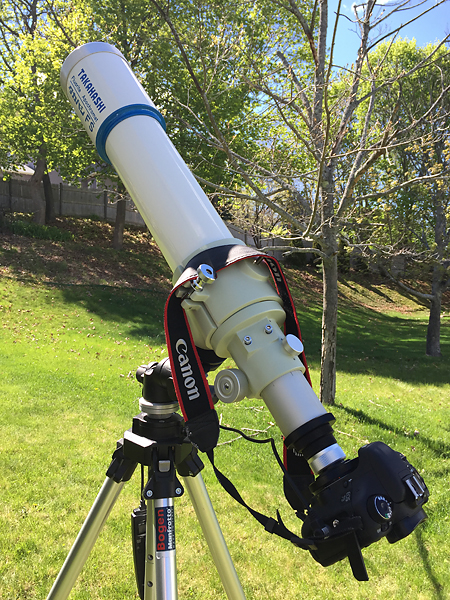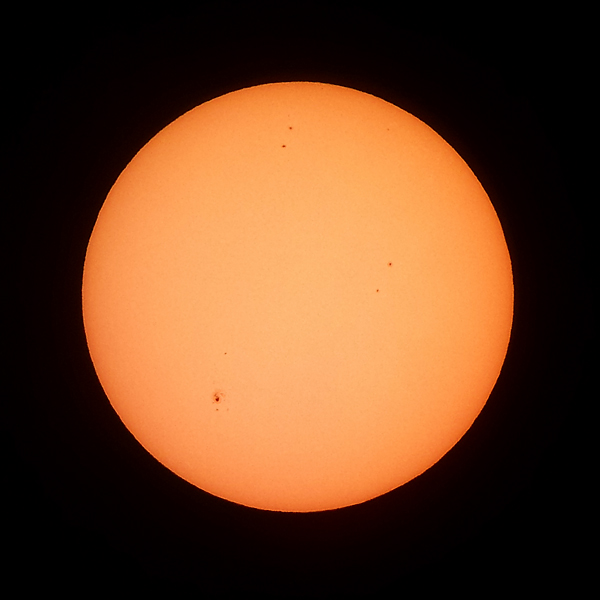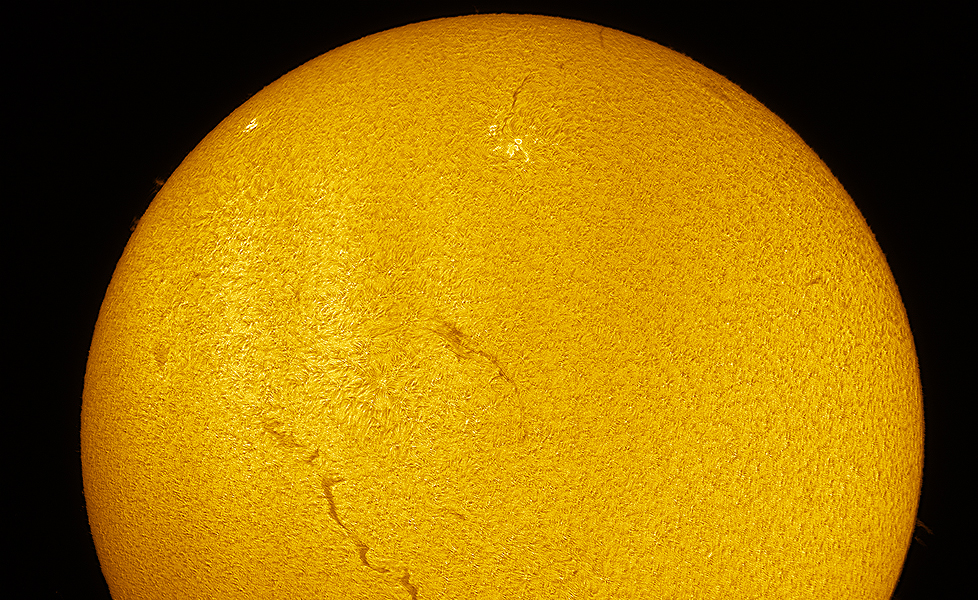How to Film or Photograph the 2019 Solar Eclipse Like a Pro
On July 2, viewers stationed along a narrow path through Chile and Argentina, will be treated to a spectacular total eclipse of the sun (provided the weather is clear). Most of the rest of South America will witness a partial eclipse of varying magnitude, depending on the observers' locations.
The path of the eclipse across the scenic Atacama Desert and Andes Mountains will make for quite a spectacle for any eclipse photographers hoping to catch the perfect shot of the eclipsed sun.
Here are some pointers to help you increase your chances of success in capturing souvenir images of the greatest celestial show of the decade. You can also check out our photo guide to photographing the solar eclipse.
WARNING: Never look directly at the sun without eye protection, such as solar-viewing glasses or a solar filter for your camera, binoculars or telescope. Failure to do so can result in serious eye injury or permanent blindness. A No. 14 arc-welder's glass filter is also acceptable, but ordinary sunglasses and polarizing or neutral-density filters used in regular photography are not safe and should not be used.
Using the right optics is key.
If you are planning to use a digital single-lens reflex (DSLR) camera to capture detailed, close-up shots of the eclipse's partial phases, Baily's beads, diamond rings, prominences and the inner corona and outer corona, you'll need to shoot through a telephoto lens or telescope of sufficient focal length, say, 500 millimeters or more. This will give you a reasonably large image of the sun's disk in the camera frame. (See the diagram in the accompanying photo gallery.)
To calculate the size of the sun's image in the frame of a DSLR with full-format (36 x 24 mm) sensor, divide the focal length of the lens in millimeters by 109. For example, a 500-mm lens will produce a solar image 4.6 mm across; a 2,000-mm lens will yield a solar disk 18.4 mm in diameter. DSLRs that use APS-C-size sensors (approximately 22 x 15 mm on Canon consumer DSLRs) will show a smaller field for a given lens due to the focal-length crop factor of 1.6.
With a telephoto lens, you can use a 2X teleconverter to boost its effective focal length. With a telescope, you can insert a Barlow lens or use the afocal imaging or eyepiece-projection technique.
Get the Space.com Newsletter
Breaking space news, the latest updates on rocket launches, skywatching events and more!

Keep it steady.
To get jitter-free shots, use a sturdy tripod or mount to support your camera setup. Don't try to hold it by hand. Make sure your tripod and head are beefy enough to carry the full load of your imaging gear. Carbon-fiber tripods are stronger and lighter than regular aluminum tripods, but they cost a bit more.
Keep the tripod low to the ground to minimize vibrations. If you need to raise the tripod's height, extend the legs, not its center column. If possible, place a vibration-suppression pad under each leg. You can also hang a heavy object, such as a backpack or a jug of water, under the tripod's center post to improve its stability.
Try to keep your setup as portable and easy to assemble and operate as possible. Portability is the key if you need to relocate in a hurry to a different site to escape clouds.
Track the sun.
If your camera setup has a relatively short focal length, then a fluid pan head offers smooth guiding when you're manually tracking the sun, which moves 0.25 degrees per minute across the sky. Keep your exposures short (no more than a second or so) to prevent the image from smearing due to Earth's rotation.
If you're using a telescope or super-long-focus telephoto lens, then an equatorial mount with slow-motion controls or motor drive would be ideal. A motor drive is convenient since it keeps the sun centered in the camera frame as you focus, adjust the exposure settings and take your shots. However, an equatorial mount must be polar-aligned, and unless you're planning to camp out at your observing site the night before the eclipse, you'll need to do that in the daytime.
If you don't want to deal with polar alignment and telescope counterweights, a better alternative would be to use a computerized GoTo altazimuth mount, such as iOptron's AZ Mount Pro. This compact, portable and lightweight mount has built-in sensors and GPS for easy setup in the field. All you have to do is level the battery-operated unit on its tripod and turn on the power; after a quick initial calibration, the mount will be ready to go.
Related: Best Telescopes for the Money

Use a safe, proper solar filter.
When shooting the eclipse's partial phases, be sure to use a solar filter mounted securely in front of your telephoto lens or telescope objective. Don't forget to place a filter over the telescope's finder scope as well.
Metal-coated glass and black polymer filters produce a pleasing yellow or orange image of the sun, while arc-welder's No. 14 glass filters give a light, greenish image. Aluminized Mylar filters show a bluish sun. Baader's AstroSolar Safety Film (made of metal-coated resin) exhibits a white image with a hint of pale purple. Suppliers of solar filters include Meade Instruments, Orion Telescopes & Binoculars, Thousand Oaks Optical, Celestron and Kendrick Astro Instruments.
Be sure to take test shots on the sun well ahead of the eclipse to determine the best exposure to use with these filters.
Set the camera to its highest resolution.
To record as much detail and color information as possible, use your camera's highest-quality (least-compressed) JPEG setting, or, better yet, its RAW file format to capture the images. Consult your camera manual on how to change the image-quality setting.
Use a high ISO setting.
Set your camera's sensitivity to ISO 400 (or higher) to keep exposures very short, thereby minimizing blurring due to vibrations or tracking errors.
Switch to manual.
Switch your camera shooting mode from Auto (A) to Manual (M) so you'll be able to control its focus and exposure settings. YourDSLR camera's autofocus and auto-exposure functions will not work on the eclipse. The same goes for the camera's pop-up flash; just turn it off completely.

Focus carefully.
Don't let poor focus ruin your images. Allow yourself enough time to focus carefully to get sharp images. If possible, prefocus your camera (without the solar filter) the night before the eclipse using a bright star. Otherwise, focus carefully (through the solar filter) on the sun's limb (the edge of the disk) or on sunspots, if there are some visible, on the morning of the eclipse. Place a piece of adhesive tape on your telephoto's focus ring (or lock the telescope focuser) to keep it from being moved accidentally during the eclipse.
Many DSLRs offer "live-view" mode that allows you to focus manually through the camera's built-in LCD screen in real time. You can even zoom-in to magnify the image up to 10X for more accurate focusing. Be sure to recheck your focus as the eclipse progresses and refine it if needed.
Minimize vibrations.
An effect called mirror slap that occurs in DSLRs creates a very small vibration in the camera that can cause blurred images. If possible, use the camera's mirror lock-up feature before each shot to keep vibrations to a minimum. Keep your exposures very short by using a high ISO setting (400 or higher). You should also operate the shutter with an electronic cable release to eliminate camera shake created by your finger pressing on the shutter button. Finally, choose your site so it's shielded from the wind. Erect a windbreak, if needed.
"Bracket" your exposures.
Digital cameras have very limited dynamic range, that is, they can't capture the full range of brightness levels of the sun's corona during totality in a single exposure. For best results, use the "bracketing" technique —taking a series of shots at various shutter speeds. This will increase your chances of getting the appropriate exposure for the scene you're interested in.
Try short exposures to record fine details in the inner corona and long exposures to capture faint streamers of the outer corona. Prominences are deceivingly bright, so you'll need to use fast shutter speeds, say, 1/500 seconds to 1/1,000 seconds, depending on your effective focal ratio and ISO setting. (Use Fred Espenak's exposure table at as a guide when bracketing your exposures.)
Don't skimp on memory cards.
Be sure to use a reliable, high-speed, large-capacity (16 gigabytes or more) memory card when shooting the eclipse. Get one with the fastest write-read speed you can afford, and keep a backup card in case of any last-minute issues.
Use a fresh battery.
DSLRs can easily drain the batteries, especially if you use the LCD screen continuously. Make sure you use a fully charged battery right before first contact, and have a spare one handy, just in case. You don't want to get that flashing low-battery icon at the most critical time.

Test your imaging setup.
Be sure to try out your setup before the eclipse. If possible, take trial shots of the sun to give yourself an idea of what exposure settings to use with your particular telescope and filter combination. These will also reveal any potential problems with focusing and vibrations, as well as internal reflections or vignetting (dimming around the edges of the image). Practice your imaging sequence over and over so you can time your pace and refine it as needed. Remember: Things will unfold very quickly right before and during totality, and you have only one chance to get it right!
If you are planning to fly to your eclipse-observing site, carefully pack each part as you disassemble your gear so you don't leave behind any essential screw, adapter or cable. Also, place delicate optics and cameras in your carry-on baggage to ensure safe handling. Check with your airline or travel agent regarding baggage size and weight restrictions to avoid unexpected fees or delays during check-in and boarding.
Catch the action.
Consider bringing a video camcorder or GoPro action camera. If you mount the camcorder on a fixed tripod and set its lens to wide angle, it can record not only the approach and retreat of the moon's shadow and totality itself, but also the excitement of the people observing in the foreground.
Shoot the partial eclipse in hydrogen-alpha.
You can also bring along a portable hydrogen-alpha telescope, such as Meade's Coronado PST or SolarMax II series. The so-called hydrogen-alpha line is a narrow wavelength of light radiated by the sun, that can be used to reveal surface structure and texture on the sun's disk, as well as prominences along the solar limb before totality.
H-alpha telescopes allow only the ruby-red light emitted by hydrogen atoms in the sun (at a wavelength of 656 nanometers) to pass through, revealing a wealth of details in the sun's chromosphere layer. Besides prominences, you'll also be able to capture other dynamic features, including plages, filaments, spicules and occasional flares.
Back up everything right away.
Immediately after the eclipse, label your memory cards and back up all the image files by copying them into a hard drive, a CD or a flash drive. Keep the originals in a separate folder or drive, and edit only copies of the images.
Process your images.
Since the camera's output is already in digital format, it's easy to process your shots using image-editing software such as Adobe Photoshop to enhance the images' brightness, contrast, sharpness and color balance. You can portray the corona's full range of brightness levels by digitally "stacking" several different exposures into a single composite image. You can also "stitch" the frames together to create an eclipse sequence or a GIF animation.
Finally, and most importantly, no matter how crazy it gets, don't forget to take a few moments to enjoy totality with your naked eye or through binoculars. (Just remember to have proper eye protection ready for when totality ends.) No photograph or video can match the real thing. Don't forget to share your experiences and photos with Space.com.
Good luck, and let's hope for clear skies on eclipse day!
Editor's Note: If you snap an amazing picture of the July 2, 2019 total solar eclipse and would like to share it with Space.com's readers, send your photos, comments, and your name and location to spacephotos@space.com.
Space.com contributors Imelda Joson and Edwin Aguirre are veteran eclipse chasers and world travelers, having organized, led and/or participated in 11 solar eclipse expeditions in North America, Asia and Africa. Follow us @Spacedotcom, Facebook and Google+. Original article on Space.com.
Join our Space Forums to keep talking space on the latest missions, night sky and more! And if you have a news tip, correction or comment, let us know at: community@space.com.
Imelda B. Joson is a veteran astrophotographer, as well as an eclipse chaser and world traveler. With her husband, Edwin Aguirre, she has organized, led and/or participated in 11 solar eclipse expeditions in North America, Asia and Africa. The pair also conceptualized and created National Astronomy Week, an event that celebrates and publicizes astronomy in the Philippines.









